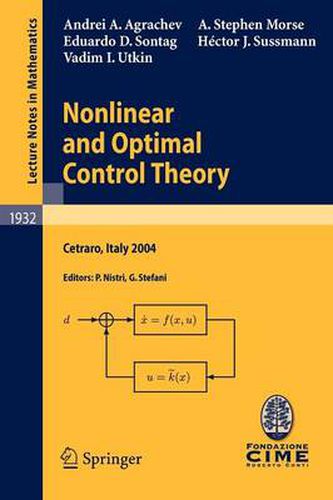Readings Newsletter
Become a Readings Member to make your shopping experience even easier.
Sign in or sign up for free!
You’re not far away from qualifying for FREE standard shipping within Australia
You’ve qualified for FREE standard shipping within Australia
The cart is loading…






This title is printed to order. This book may have been self-published. If so, we cannot guarantee the quality of the content. In the main most books will have gone through the editing process however some may not. We therefore suggest that you be aware of this before ordering this book. If in doubt check either the author or publisher’s details as we are unable to accept any returns unless they are faulty. Please contact us if you have any questions.
Mathematical Control Theory is a branch of Mathematics having as one of its main aims the establishment of a sound mathematical foundation for the c- trol techniques employed in several di?erent ?elds of applications, including engineering,economy,biologyandsoforth. Thesystemsarisingfromthese- plied Sciences are modeled using di?erent types of mathematical formalism, primarily involving Ordinary Di?erential Equations, or Partial Di?erential Equations or Functional Di?erential Equations. These equations depend on oneormoreparameters thatcanbevaried,andthusconstitute thecontrol - pect of the problem. The parameters are to be chosen soas to obtain a desired behavior for the system. From the many di?erent problems arising in Control Theory, the C. I. M. E. school focused on some aspects of the control and op- mization ofnonlinear, notnecessarilysmooth, dynamical systems. Two points of view were presented: Geometric Control Theory and Nonlinear Control Theory. The C. I. M. E. session was arranged in ?ve six-hours courses delivered by Professors A. A. Agrachev (SISSA-ISAS, Trieste and Steklov Mathematical Institute, Moscow), A. S. Morse (Yale University, USA), E. D. Sontag (Rutgers University, NJ, USA), H. J. Sussmann (Rutgers University, NJ, USA) and V. I. Utkin (Ohio State University Columbus, OH, USA). We now brie?y describe the presentations. Agrachev’s contribution began with the investigation of second order - formation in smooth optimal control problems as a means of explaining the variational and dynamical nature of powerful concepts and results such as Jacobi ?elds, Morse’s index formula, Levi-Civita connection, Riemannian c- vature.
$9.00 standard shipping within Australia
FREE standard shipping within Australia for orders over $100.00
Express & International shipping calculated at checkout
Stock availability can be subject to change without notice. We recommend calling the shop or contacting our online team to check availability of low stock items. Please see our Shopping Online page for more details.
This title is printed to order. This book may have been self-published. If so, we cannot guarantee the quality of the content. In the main most books will have gone through the editing process however some may not. We therefore suggest that you be aware of this before ordering this book. If in doubt check either the author or publisher’s details as we are unable to accept any returns unless they are faulty. Please contact us if you have any questions.
Mathematical Control Theory is a branch of Mathematics having as one of its main aims the establishment of a sound mathematical foundation for the c- trol techniques employed in several di?erent ?elds of applications, including engineering,economy,biologyandsoforth. Thesystemsarisingfromthese- plied Sciences are modeled using di?erent types of mathematical formalism, primarily involving Ordinary Di?erential Equations, or Partial Di?erential Equations or Functional Di?erential Equations. These equations depend on oneormoreparameters thatcanbevaried,andthusconstitute thecontrol - pect of the problem. The parameters are to be chosen soas to obtain a desired behavior for the system. From the many di?erent problems arising in Control Theory, the C. I. M. E. school focused on some aspects of the control and op- mization ofnonlinear, notnecessarilysmooth, dynamical systems. Two points of view were presented: Geometric Control Theory and Nonlinear Control Theory. The C. I. M. E. session was arranged in ?ve six-hours courses delivered by Professors A. A. Agrachev (SISSA-ISAS, Trieste and Steklov Mathematical Institute, Moscow), A. S. Morse (Yale University, USA), E. D. Sontag (Rutgers University, NJ, USA), H. J. Sussmann (Rutgers University, NJ, USA) and V. I. Utkin (Ohio State University Columbus, OH, USA). We now brie?y describe the presentations. Agrachev’s contribution began with the investigation of second order - formation in smooth optimal control problems as a means of explaining the variational and dynamical nature of powerful concepts and results such as Jacobi ?elds, Morse’s index formula, Levi-Civita connection, Riemannian c- vature.